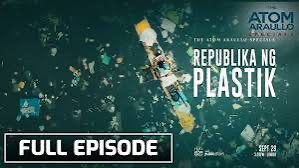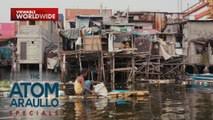PlastiCon 2025: When Science Finds a Soul
- Hungrytravelduo
- Jul 27
- 6 min read
Asia was still grieving. It was 2005, months after the tsunami had ripped through coastlines and lives. My father had just been invited to speak at the International Peace Conference in Thailand—on climate change, a topic still whispered about in policy rooms, rarely in living rooms.
He asked me for help. I wasn’t a scientist—not even close, even till now. But I cared deeply about animals. About people. And I knew how to tell a story.
So I created a simple video.
In it, I pieced together images and short clips of melting ice caps, starving polar bears, trash floating in oceans, and the chain of destruction our carelessness had begun—how displaced animals were a warning, a mirror of what would soon displace and destroy us too. That video played in a hall filled with peace advocates, business leaders, even heads of state. By the end, half the room was moved in tears.

That moment carved a space in me—a quiet, lifelong ache to do something. Even if I didn’t speak the language of science, I knew the language of empathy. And that would have to be enough.
Fast forward to a few months ago. I met Dr. Deo Florence Onda at a Geocycle event, calmly presenting the hard facts: microplastics are everywhere—in our oceans, our food, even our bloodstream. As expected, he delivered it with the precision of a seasoned academic. For many in the room, his data painted a sobering picture.
But to most, it still felt clinical. Distant.Then he said something unexpected:
“Join us at PlastiCon in July 2025. There, you’ll see how it all connects.” He wasn’t wrong.
Science at the Heart of the Movement
It’s no small thing that this is all happening at the UP Marine Science Institute (MSI). After all, MSI is the scientific heart of the Philippines’ battle for its oceans—championed by world-renowned microbial oceanographers like Dr. Onda. His groundbreaking work—plumbing the deepest trenches of our seas—brings back invaluable knowledge.
The research conducted here by Dr. Onda and his colleagues provides the hard, undeniable data that underpins every meaningful conversation about conservation. It’s the science that strips away excuses and grounds the entire event in fact.
We Are Now Made of Plastic
Dr. Onda returned to the spotlight, introducing his colleagues and invited panelists—this time with haunting visuals. Through vivid slides and grounded language, these scientists and sustainability advocates unraveled how plastic pollution has seeped into every ecosystem, including ours.

Microplastics have been found in the placenta of unborn children, in the lungs of healthy adults, in the fish we eat. He didn’t need to sensationalize it—the facts were disturbing enough. In fact, did you know we consume the equivalent of one plastic card per year in microplastics?
This wasn’t just about “saving the ocean” anymore.
It was about saving ourselves—from ourselves.
For someone like me, who once found science intimidating, this space made it digestible. Emotional, even. Because when science is told with soul, it becomes everyone’s story.
Leadership That Actually Shows Up
On Day 1, Mayor Joy Belmonte took the stage—not with vague promises, but with proof. She walked us through Quezon City’s extensive programs: waste segregation, incentives for community-led materials recovery like the Trash to Cash program, livelihood initiatives for women in custody, and aggressive efforts to reduce landfill dependency.

In a country often weighed down by red tape and resignation, her voice cut through with clarity: Change is happening. It’s possible.

The following day, we heard from Hon. Rey Amador Bargamento, Barangay Captain of Mintal in Davao. His talk was humble but striking—proof that even the smallest local leaders can pioneer change. From grassroots waste management to community buy-ins, he reminded us that the fight doesn’t start in national halls. It starts in barangays.
Imagine this: kids as young as 7 are excited to pick up trash in their own backyards. Moving.
When Art Screams Back
The most haunting and unforgettable moment of the conference came during the evening opening of the “Collision” art gallery. The event began with a powerful cultural performance from neo-ethnic ensemble Kontra-Gapi—a musical ritual that stirred a sense of ancestral urgency.
But it was what followed that left the audience shaken.


In a bold performance art piece curated by visual artist and gallery curator Lara Latosa, a once-pristine painting was deliberately vandalized in front of the audience—not by vandals, but by herself, the participants, scientists, and artists alike.

What started as a portrait evolved into a chaotic burst of rage, grief, and protest. Splashes of red and black cut through the canvas. Sharp strokes, heavy words, and raw graffiti engulfed the image—bearing phrases like “Trash-Free Seas,” “Genocide of Our Oceans,” and “Act Now.”
The act wasn’t just symbolic. It was participatory. The audience, including MSI staff and PlastiCon attendees, took part in the defacement—each brushstroke a catharsis, each bleeding letter a plea. Newspapers and paint-stained tarps littered the floor, mimicking the polluted shorelines we too often ignore.
It was a confrontation—not with the art, but with ourselves. Chilling.
The Documentary That Broke the Silence
One of the most powerful moments at PlastiCon 2025 was a reminder that data alone doesn't move hearts—but stories do. Atom Araullo’s documentary, Republika ng Plastik, was a visceral centerpiece of this shift.
He took viewers deep into the heart of places like Tondo and Montalban, where plastic pollution isn’t just a statistic—it’s a lived reality. In narrow alleys and clogged esteros, uncollected waste turns low-lying communities into disaster zones each time the rain pours.
Families wade through floodwaters filled with plastic. Children suffer chronic skin conditions and respiratory illnesses. Plastic is no longer just a nuisance—it’s a public health crisis.

The film also shows the paradox: for many, plastic has become a means of survival. Waste workers, armed with only sacks and sheer will, scour dumpsites and rivers for recyclables—earning just enough to get by, even if it means inhaling toxic fumes or standing knee-deep in garbage.
Then there are the coastlines—once teeming with marine life, now graveyards of plastic. Sea turtles wash up lifeless, stomachs filled with bottle caps and wrappers. Fishermen now haul in more trash than fish. The ocean is suffocating.
But Republika ng Plastik does more than document tragedy. It reminds us: plastic pollution isn’t just a marine issue. It’s a human rights issue. A class issue. A survival issue.
This is why media matters.Because when facts fail to move us, stories do.When numbers blur into noise, human faces cut through.When apathy sets in, storytelling awakens something deeper—urgency, compassion, action.
Where the Real Work Begins
PlastiCon wasn’t perfect. But it did something most summits rarely achieve—it cracked something open. It connected dots that often stay isolated: science and storytelling, policy and passion, data and deeply personal truths.

In every corner of the venue, art and activism stood side by side. Scientists shared panels with artists. Students challenged experts. Lawmakers sat beside coastal community leaders.
Some shed tears. Others voiced frustrations. All of us, at some point, felt something shift.
It was messy. It was raw. It was human.
For the first time in a long time, I saw science step out of its silo. It breathed through the crowd—in conversations, in confrontations, in silent moments of shared grief and collective awe.
This wasn’t just about plastic anymore.This was about us—our habits, our histories, and what kind of future we’re willing to fight for.
The Revolution Starts With Us
If we truly want to break the cycle, we have to start where every real movement begins—not in legislation, not in laboratories, but in the hearts of people.
Raise children who know the journey of a plastic bottle—not just its use, but its afterlife. Build communities where sustainability is not a buzzword, but a value as fundamental as honesty or respect. Cultivate a culture where caring is cool, and action is contagious.

We don’t need to be billionaires, scientists, or politicians to create change. You don’t even need a title. What we need are more people who care deeply and act consistently—who amplify truths in whatever way they can: through art, teaching, business, storytelling, or simply choosing to live with intention.
Real impact doesn’t always begin in power.
Sometimes it begins with a parent starting a cleanup with their child.A teacher rewriting their lesson plans.A creator sharing the truth in a viral video.A private citizen saying, “Not on my watch.”
You don’t need millions. You don’t need a microphone. You just need heart. Passion. And a belief that the world is still worth fighting for—together.
This is the work. And it belongs to all of us.




















Comments